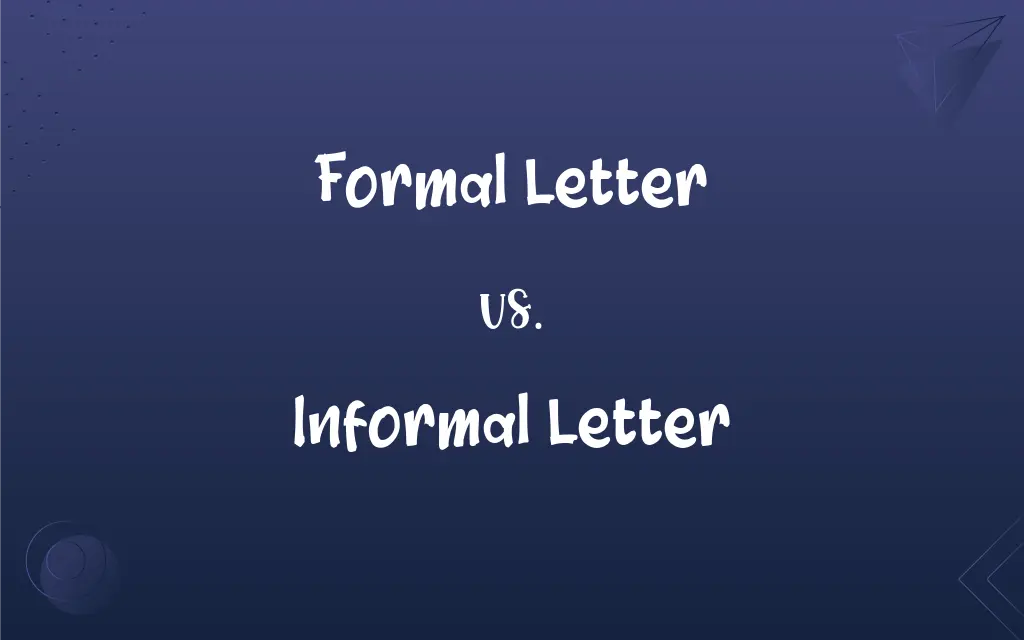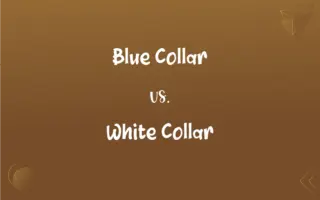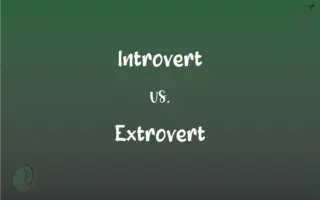Formal Letter vs. Informal Letter: What's the Difference?
Edited by Aimie Carlson || By Harlon Moss || Updated on October 2, 2023
Formal letter means a structured correspondence following specific conventions, used for professional or communication while, informal letter is a casual correspondence, generally used for personal communications, without adherence to strict conventions.

Key Differences
A formal letter is typically characterized by a specific structure and format, utilized in professional, academic, or official communications. An informal letter, conversely, has a flexible structure, often used in personal or casual exchanges with acquaintances or loved ones.
Formal letters are often hallmarked by a tone of formality and politeness, abiding by certain conventions and etiquette. Informal letters adopt a conversational and friendly tone, where rules of formal communication can be overlooked without consequence.
The addressing and closing in a formal letter follow strict conventions, always maintaining a sense of respect and professionalism. An informal letter, however, employs casual and personal greetings and closings, reflecting familiarity and closeness.
In a formal letter, the language employed is typically standard, official, and avoids the use of slang or colloquial expressions. An informal letter freely employs everyday language, colloquialisms, and can include slang, depending on the relationship between correspondents.
Formal letters strictly adhere to grammar rules and punctuation norms to maintain clarity and professionalism. Informal letters permit a more lenient approach to grammar and punctuation, prioritizing ease and flow of communication.
ADVERTISEMENT
Comparison Chart
Tone
Formal and respectful
Casual and friendly
Structure and Format
Strict and conventional
Flexible and free-form
Language
Standard English, no slang
Everyday language, may use slang
Purpose
Professional, official, or academic communication
Personal, casual communication
Salutation and Closing
Strict conventions and formality
Casual, can be emotionally expressive
ADVERTISEMENT
Formal Letter and Informal Letter Definitions
Formal Letter
Precise language and clarity are paramount in formal letters.
We aim to address the outlined concerns, demonstrates clarity in a formal letter.
Informal Letter
An informal letter embraces a relaxed, personal tone.
Hey buddy! How've you been? is a typical opening in an informal letter.
Formal Letter
A formal letter typically avoids personal anecdotes and focuses on objective information.
According to the data provided, keeps the focus on objective information in a formal letter.
Informal Letter
The structure of an informal letter is flexible and non-conventional.
Sending you tons of love, can be a closing in an informal letter.
Formal Letter
A formal letter adheres to established conventions in its structure and language.
In a formal letter, one might begin with Dear Sir/Madam,.
Informal Letter
Informal letters often convey personal news and emotions.
I was over the moon to hear from you! is an emotionally expressive sentence in an informal letter.
Formal Letter
Formal letters are utilized for professional or official communication.
We hereby submit our proposal, is common to read in a formal letter.
Informal Letter
Informal letters allow for colloquial language and expressions.
Can't wait to catch up soon! exhibits a casual expression in an informal letter.
Formal Letter
Formal letters exhibit politeness and adhere to etiquette.
We appreciate your timely response, shows politeness in a formal letter.
Informal Letter
Informal letters do not adhere strictly to grammatical norms.
Me and Jake are planning a trip, might appear in an informal letter despite the grammatical lapse.
FAQs
What is a formal letter?
A formal letter follows a structured format and formal language, often used for professional or official communication.
When is a formal letter used?
It's used for professional, academic, and official communications, such as job applications or inquiries.
What are the parts of a formal letter?
Key parts include the sender's and recipient's addresses, date, salutation, body, closing, and signature.
How should a formal letter be addressed?
Typically, it's addressed using formal titles and the recipient’s last name, e.g., “Dear Dr. Smith.”
Can informal language be used in an informal letter?
Yes, colloquialisms, slang, and contractions are typically acceptable.
Can informal letters be sent via email or social media?
Yes, informal letters can be conveyed through various communication platforms.
Is a formal letter always typed?
Generally, yes, to maintain professionalism and legibility.
Should a formal letter be concise?
Yes, clear and to-the-point content is preferred to respect the recipient’s time and attention.
Can an informal letter contain drawings or doodles?
Yes, informal letters can include personal touches like drawings, photos, or other mementos.
Can a formal letter be handwritten?
While uncommon and less professional, it may be acceptable in certain, very specific contexts.
Can a formal letter be sent via email?
Yes, when sent via email, the format should generally be preserved in the message or an attachment.
What is an informal letter?
An informal letter is a casually-styled message, usually intended for personal communication.
When is an informal letter appropriate?
It's suited for non-official communication, such as letters to friends or family members.
Is a signature necessary in a formal letter?
Yes, a signature is typically required to authenticate and formalize communication.
Do informal letters require a signature?
While common, a signature is not strictly required and depends on the sender’s style.
Are there length requirements for an informal letter?
No, the length can be adapted to the content and the relationship between sender and recipient.
How formal should the language be?
The language should be very formal, avoiding slang and contractions.
Is an informal letter always handwritten?
Not necessarily; it can be typed or handwritten, depending on the sender's preference.
Does an informal letter require strict formatting?
No, informal letters allow for personal style and do not adhere to rigid formatting rules.
How should an informal letter be addressed?
Often with familiar or affectionate terms, like “Dear [First Name],” or even nicknames.
About Author
Written by
Harlon MossHarlon is a seasoned quality moderator and accomplished content writer for Difference Wiki. An alumnus of the prestigious University of California, he earned his degree in Computer Science. Leveraging his academic background, Harlon brings a meticulous and informed perspective to his work, ensuring content accuracy and excellence.
Edited by
Aimie CarlsonAimie Carlson, holding a master's degree in English literature, is a fervent English language enthusiast. She lends her writing talents to Difference Wiki, a prominent website that specializes in comparisons, offering readers insightful analyses that both captivate and inform.































































